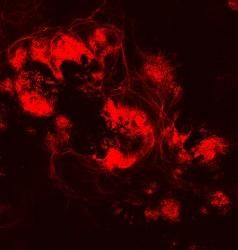A Trojan horse against tuberculosis
New transport route for antibiotics directly into infected cells
Advertisement
tuberculosis is still the infectious disease that is responsible for the highest number of deaths worldwide. It is caused by Mycobacterium tuberculosis, a bacterium that infects cells in the lungs. There, the pathogen is hardly accessible to most antibiotics. In addition, resistance to existing drugs is increasing. In order to improve treatment with reserve antibiotics, researchers from TWINCORE, together with partners from the Hannover Medical School and the Helmholtz Institute for Pharmaceutical Research Saarland, have found a way to transport the active substances directly into the infected cells. To do this, they package the antibiotics in so-called liposomes.

Symbolic image
pixabay.com
Only a few reserve antibiotics are still available for the treatment of multi-resistant mycobacteria, against which most antibiotics are no longer effective. They have the disadvantage that they can only penetrate the cells in which the bacterium is present with difficulty. The high concentrations of the drugs that are necessary for this reason have to be administered intravenously and have severe side effects. If the therapy is stopped too early, the germs develop new resistances. To break this vicious circle, scientists at TWINCORE have now developed an innovative approach.
"We have packaged the antibiotics in small lipid droplets that are additionally equipped with sugar molecules," says Verónica Durán, research associate at the Institute for Experimental Infection Research and first author of the publication. "These nanoparticles, called liposomes, interact with the same receptors as the mycobacteria and are therefore transported into the cells via the same transport route as the pathogens, almost like a Trojan horse." The active substance then reaches exactly where it is needed: directly into the host cells of Mycobacterium tuberculosis, the so-called alveolar macrophages in the lungs.
The advantages of this nanoformulation are obvious. "We can directly treat the infected immune cells in the lungs," says Theresa Graalmann, a physician scientist at MHH and TWINCORE. "It might be possible to lower the dosage of the drugs or shorten the duration of the therapy." Graalmann led the project together with Ulrich Kalinke, Director of the Institute for Experimental Infection Research and Managing Director of TWINCORE, and Elena Grabski, who now works at the Paul Ehrlich Institute in Langen.
To arrive at their findings, the researchers also used CRISPR/Cas9 technology. This molecular biological system for editing genes, often referred to as "gene scissors", was awarded the Nobel Prize in Chemistry last year. It is now routinely used in the laboratory, mostly in established cell lines. "However, in order to understand the mechanism of liposome entry into cells, we modified primary human immune cells, which are cells isolated directly from donor blood samples," says Berislav Bošnjak, scientist at the Institute of Immunology at MHH. These cells are much more difficult to handle in the laboratory than cell lines. "This shows once again how useful CRISPR/Cas9 has become in research."
The next step would now be to transfer it to clinical application. "Further development is quite expensive. For that, we would need additional financial support, for example from an investor," says research director Ulrich Kalinke. It is still a long way until then. Nevertheless, he is certain: "I am confident that this principle will one day become established for the treatment of tuberculosis and also other infectious diseases."
Original publication
Durán V, Grabski E, Hozsa C, Becker J, Yasar H, Monteiro J, Costa B, Koller N, Lüder Y, Wiegmann B, Brandes G, Käver V, Lehr C-M, Lepenies B, Tampé R, Förster R, Bošnjak B, Furch M, Graalmann T, Kalinke U; "Fucosylated lipid nanocarriers loaded with antibiotics efficiently inhibit mycobacterial propagation in human myeloid cells"; J Control Release; 2021, 334:201-212.


















































